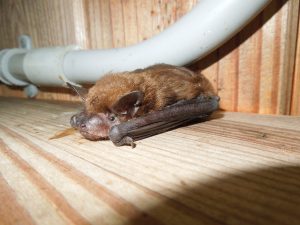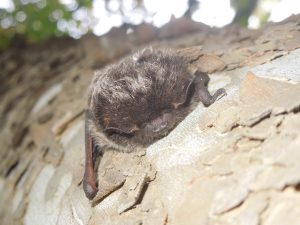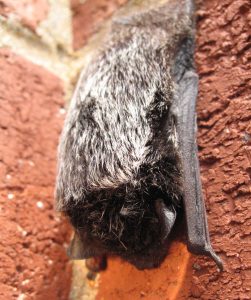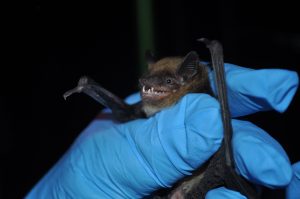The silhouettes of a group of bats flying through the evening sky, swooping to capture flying insects raised many questions for me — How much do they eat? Where do they go during the day or in winter? What about vampire bats and diseases? How can I see more bats?

Determined to find out, I turned to Jean Mengelkoch, a mammalogist at INHS. Accordinig to Jean, there are approximately 1,200 bat species worldwide, all belonging to the order Chiroptera, meaning hand-wing. The wing is made up of elongated forearm and finger bones covered by a strong, thin membrane. The thumb is not covered by the membrane and has a claw to allow grasping.
Approximately one-third of bat species eat fruit or nectar, serving as pollinators and seed dispersers in the process. The largest species of bat, the Malaysian flying fox, is a fruit eater, using its strong senses of sight and smell to locate food. These bats have a wingspan of over five feet. The smallest bat species in the world is the bumblebee bat, with a body length of one inch and a wingspan of only six inches. The bumblebee bat and two-thirds of all bat species are insectivores, finding prey by echolocation —emitting sound waves and sensing their reflection. Bats have voracious appetites, with individuals capable of eating 1,000 small insects per hour.

All 13 species of bat found in Illinois are insectivores and consume large numbers of insects whose larvae destroy farm crops, including cutworms, rootworms, and leafhoppers. There are only three species of “vampire” bats, all living in Latin and South America. Unlike most bats, vampire bats are capable of walking or running, allowing them to sneak up on their prey. They do not suck the blood of their prey, rather they bite and lap up the blood, needing only about a teaspoon per meal. The saliva of these bats has a potent enzyme that is capable of dissolving blood clots, allowing blood to flow freely. This enzyme is used in medicines to dissolve blood clots in human stroke victims.
Roosting
During the spring, summer, and fall, bats roost in a variety of places — in trees, under tree bark, or in buildings and caves. Some bats, including the eastern red bat and the hoary bat, roost in solitary, while others gather in colonies. Bat feet, like those of many birds, are locked in a curved position, allowing them to hang with little effort. But unlike most birds, bats hang upside down. Scientists aren’t certain why they hang upside down, but one reason might be that the leg bones are too weak to support standing. Hanging upside down also allows the bats to attain flight quickly by releasing from their roost and flapping while free falling.
Migration

Most people are familiar with birds, and even some insects, flying south for the winter. Many Illinois bat species migrate between summer habitats and caves or mines for the winter. Some bats, including the big brown bat, are considered sedentary, traveling only short distances, if at all, between summer and winter habitats. Regional migrants, for example the eastern pipistrelle, Indiana bat, little brown bat, and northern bat, travel between 60 and 300 miles to the nearest hibernaculum. These subterranean habitats do not have to be to the south, so some bats will even migrate north to their winter caves. Long distance migrants are capable of traveling over 600 miles and include the evening bat, hoary bat, red bats, and silver-haired bats. Some of these migrate to areas where food is still plentiful in the winter months. In Missouri, red bats will actively feed during the winter and can take shelter in the leaf litter.
Torpor
Bats have a resting heartbeat of approximately 300 to 400 beats per minute (bpm), but are capable of dropping that rate to as low as 10 bpm to conserve energy during periods of limited food resources. Some species of bat can enter this state, known as torpor, for a few hours each day during the spring, summer, and fall. During the winter, torpor can last a few days to a few weeks, with periods of arousal.
Diseases
 Rabies is carried by less than 0.5% of wild bats, and even though this is relatively rare, NEVER touch a bat. If you find a bat flying around in your house, open the windows to allow it to fly out or if it has landed, put a pail over it and slide cardboard between the pail and the wall and take it outside to release. If you have large numbers of bats living in your home, there is the danger of a buildup of guano that can contain histoplasmosis. Consult the Bat Conservation International Web site for suggestions. http://www.batcon.org
Rabies is carried by less than 0.5% of wild bats, and even though this is relatively rare, NEVER touch a bat. If you find a bat flying around in your house, open the windows to allow it to fly out or if it has landed, put a pail over it and slide cardboard between the pail and the wall and take it outside to release. If you have large numbers of bats living in your home, there is the danger of a buildup of guano that can contain histoplasmosis. Consult the Bat Conservation International Web site for suggestions. http://www.batcon.org
This was originally published in INHS Reports No. 409 – Winter 2013
Learn more about PACE Lab’s bat research